Investigating Discrimination and Mental Health in Lewisham: A Report
VerifiedAdded on 2022/07/27
|24
|5633
|93
Report
AI Summary
This report investigates the correlation between racial discrimination and mental health among young black individuals residing in the London borough of Lewisham. The research employs questionnaires as its primary methodology, targeting individuals aged 17-18. The study addresses the impact of discrimination on mental well-being, examining key inequalities, including social exclusion, unemployment, and poverty. It reviews existing literature on racial discrimination and mental health, considering factors such as the Race Relations Act of 1965 and its subsequent amendments, as well as the mental health of Lewisham's Black minority population. The report explores the role of research in understanding these issues and evaluates the author's research and writing skills. It highlights the importance of addressing the problem of racial discrimination and its effects on the mental health of the target population, including the increased risk of schizophrenia. The research aims to contribute to the progress of knowledge in this field, providing valuable insights into the complex interplay between race, mental health, and social environment.

Unit 18: Innovation and Improvement
through Action Research (L5)
through Action Research (L5)
Paraphrase This Document
Need a fresh take? Get an instant paraphrase of this document with our AI Paraphraser
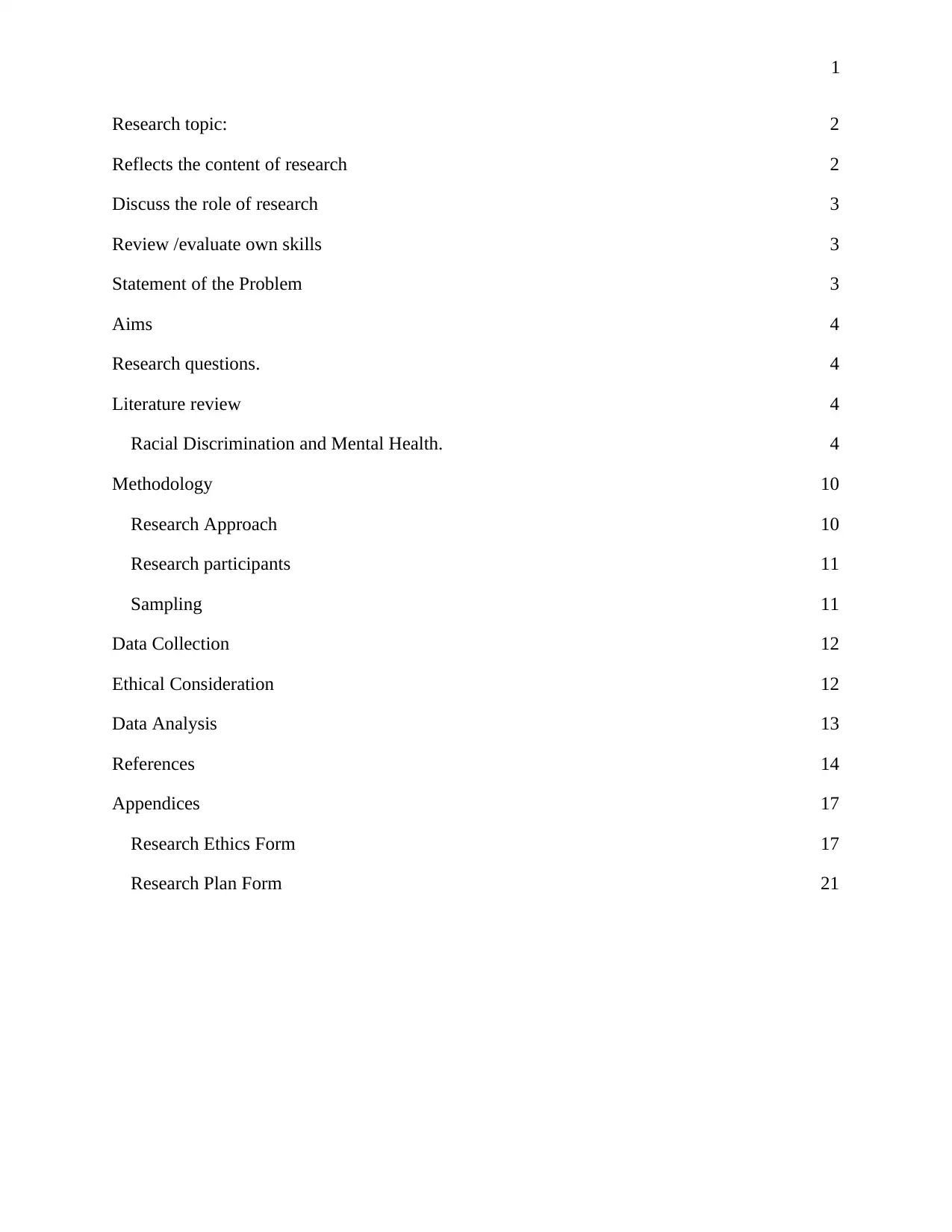
1
Research topic: 2
Reflects the content of research 2
Discuss the role of research 3
Review /evaluate own skills 3
Statement of the Problem 3
Aims 4
Research questions. 4
Literature review 4
Racial Discrimination and Mental Health. 4
Methodology 10
Research Approach 10
Research participants 11
Sampling 11
Data Collection 12
Ethical Consideration 12
Data Analysis 13
References 14
Appendices 17
Research Ethics Form 17
Research Plan Form 21
Research topic: 2
Reflects the content of research 2
Discuss the role of research 3
Review /evaluate own skills 3
Statement of the Problem 3
Aims 4
Research questions. 4
Literature review 4
Racial Discrimination and Mental Health. 4
Methodology 10
Research Approach 10
Research participants 11
Sampling 11
Data Collection 12
Ethical Consideration 12
Data Analysis 13
References 14
Appendices 17
Research Ethics Form 17
Research Plan Form 21
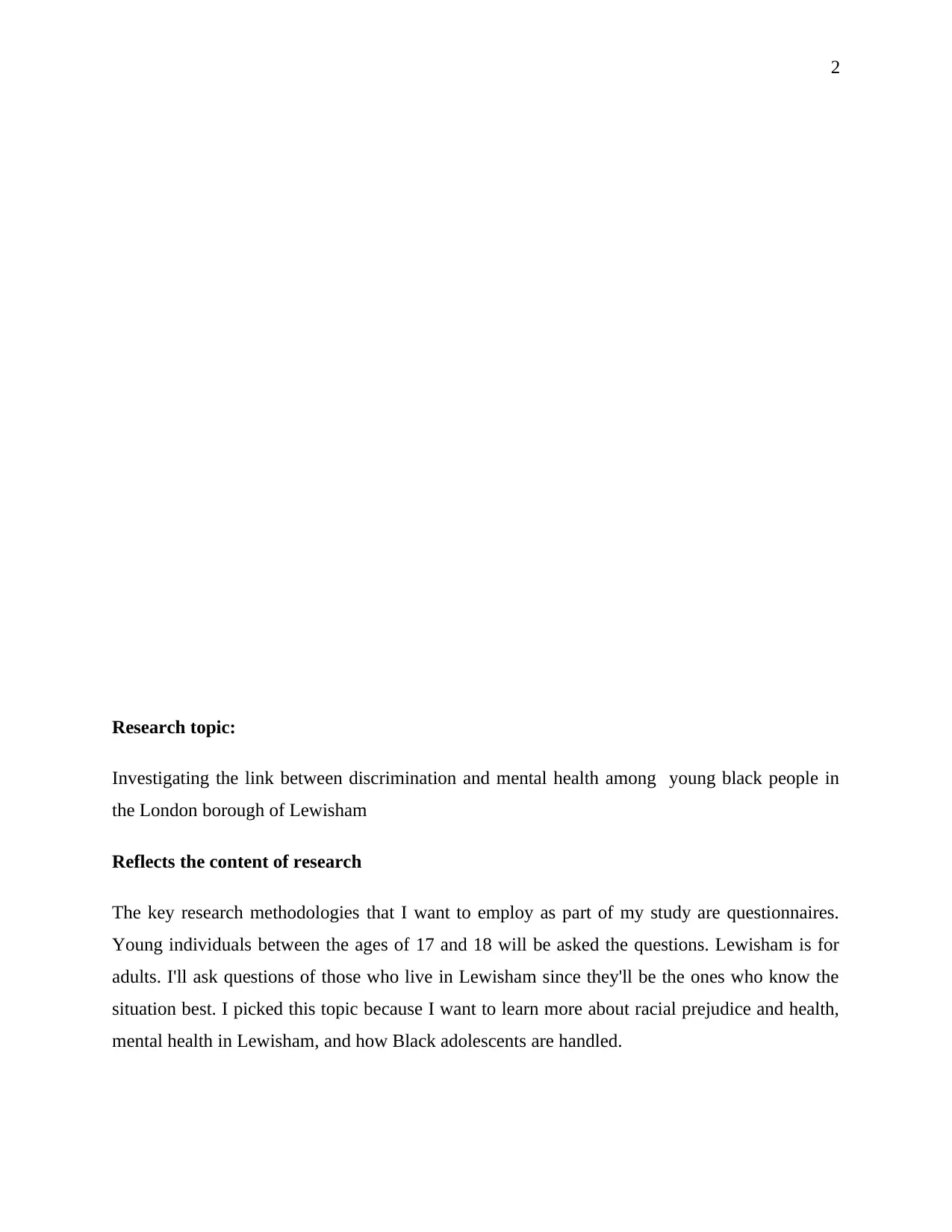
2
Research topic:
Investigating the link between discrimination and mental health among young black people in
the London borough of Lewisham
Reflects the content of research
The key research methodologies that I want to employ as part of my study are questionnaires.
Young individuals between the ages of 17 and 18 will be asked the questions. Lewisham is for
adults. I'll ask questions of those who live in Lewisham since they'll be the ones who know the
situation best. I picked this topic because I want to learn more about racial prejudice and health,
mental health in Lewisham, and how Black adolescents are handled.
Research topic:
Investigating the link between discrimination and mental health among young black people in
the London borough of Lewisham
Reflects the content of research
The key research methodologies that I want to employ as part of my study are questionnaires.
Young individuals between the ages of 17 and 18 will be asked the questions. Lewisham is for
adults. I'll ask questions of those who live in Lewisham since they'll be the ones who know the
situation best. I picked this topic because I want to learn more about racial prejudice and health,
mental health in Lewisham, and how Black adolescents are handled.
⊘ This is a preview!⊘
Do you want full access?
Subscribe today to unlock all pages.

Trusted by 1+ million students worldwide
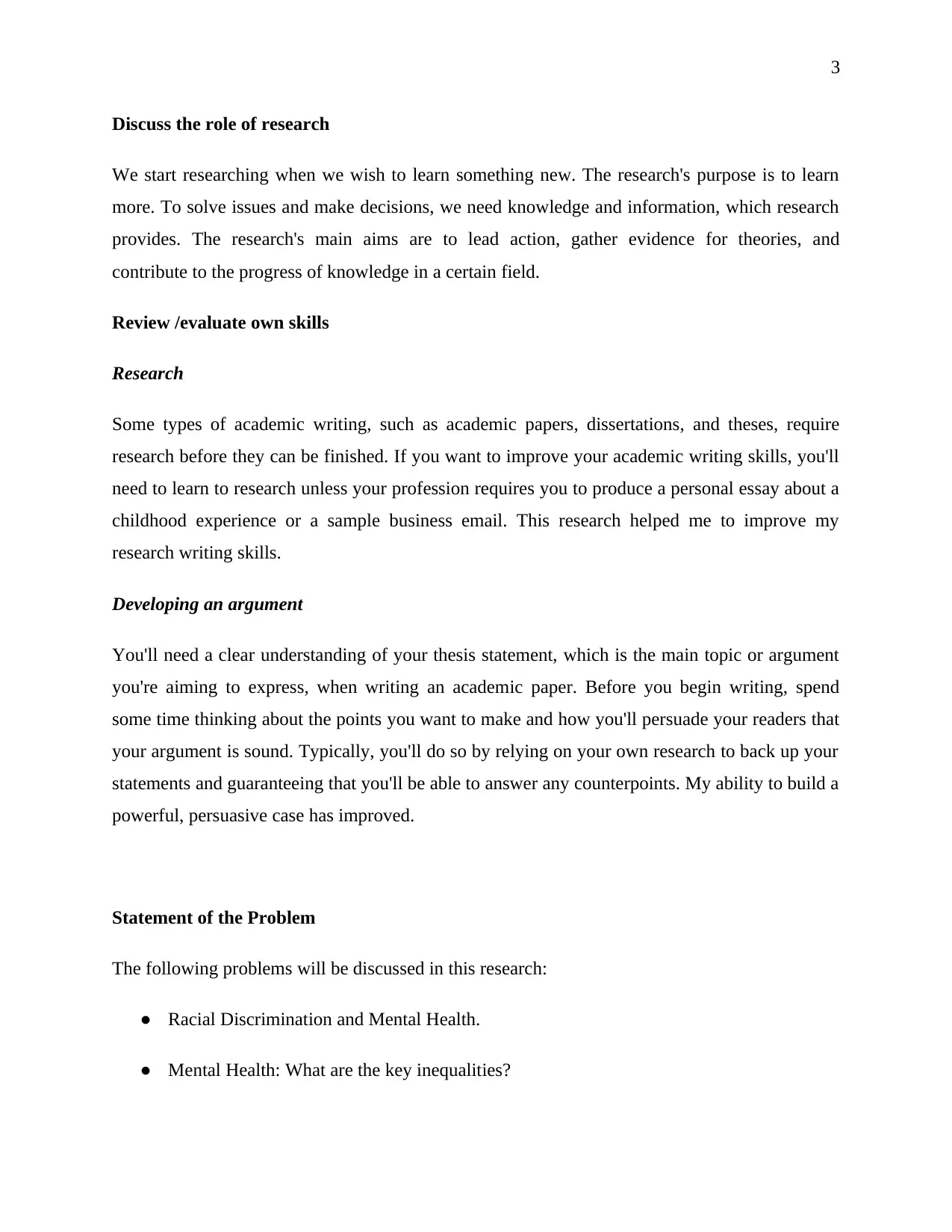
3
Discuss the role of research
We start researching when we wish to learn something new. The research's purpose is to learn
more. To solve issues and make decisions, we need knowledge and information, which research
provides. The research's main aims are to lead action, gather evidence for theories, and
contribute to the progress of knowledge in a certain field.
Review /evaluate own skills
Research
Some types of academic writing, such as academic papers, dissertations, and theses, require
research before they can be finished. If you want to improve your academic writing skills, you'll
need to learn to research unless your profession requires you to produce a personal essay about a
childhood experience or a sample business email. This research helped me to improve my
research writing skills.
Developing an argument
You'll need a clear understanding of your thesis statement, which is the main topic or argument
you're aiming to express, when writing an academic paper. Before you begin writing, spend
some time thinking about the points you want to make and how you'll persuade your readers that
your argument is sound. Typically, you'll do so by relying on your own research to back up your
statements and guaranteeing that you'll be able to answer any counterpoints. My ability to build a
powerful, persuasive case has improved.
Statement of the Problem
The following problems will be discussed in this research:
● Racial Discrimination and Mental Health.
● Mental Health: What are the key inequalities?
Discuss the role of research
We start researching when we wish to learn something new. The research's purpose is to learn
more. To solve issues and make decisions, we need knowledge and information, which research
provides. The research's main aims are to lead action, gather evidence for theories, and
contribute to the progress of knowledge in a certain field.
Review /evaluate own skills
Research
Some types of academic writing, such as academic papers, dissertations, and theses, require
research before they can be finished. If you want to improve your academic writing skills, you'll
need to learn to research unless your profession requires you to produce a personal essay about a
childhood experience or a sample business email. This research helped me to improve my
research writing skills.
Developing an argument
You'll need a clear understanding of your thesis statement, which is the main topic or argument
you're aiming to express, when writing an academic paper. Before you begin writing, spend
some time thinking about the points you want to make and how you'll persuade your readers that
your argument is sound. Typically, you'll do so by relying on your own research to back up your
statements and guaranteeing that you'll be able to answer any counterpoints. My ability to build a
powerful, persuasive case has improved.
Statement of the Problem
The following problems will be discussed in this research:
● Racial Discrimination and Mental Health.
● Mental Health: What are the key inequalities?
Paraphrase This Document
Need a fresh take? Get an instant paraphrase of this document with our AI Paraphraser
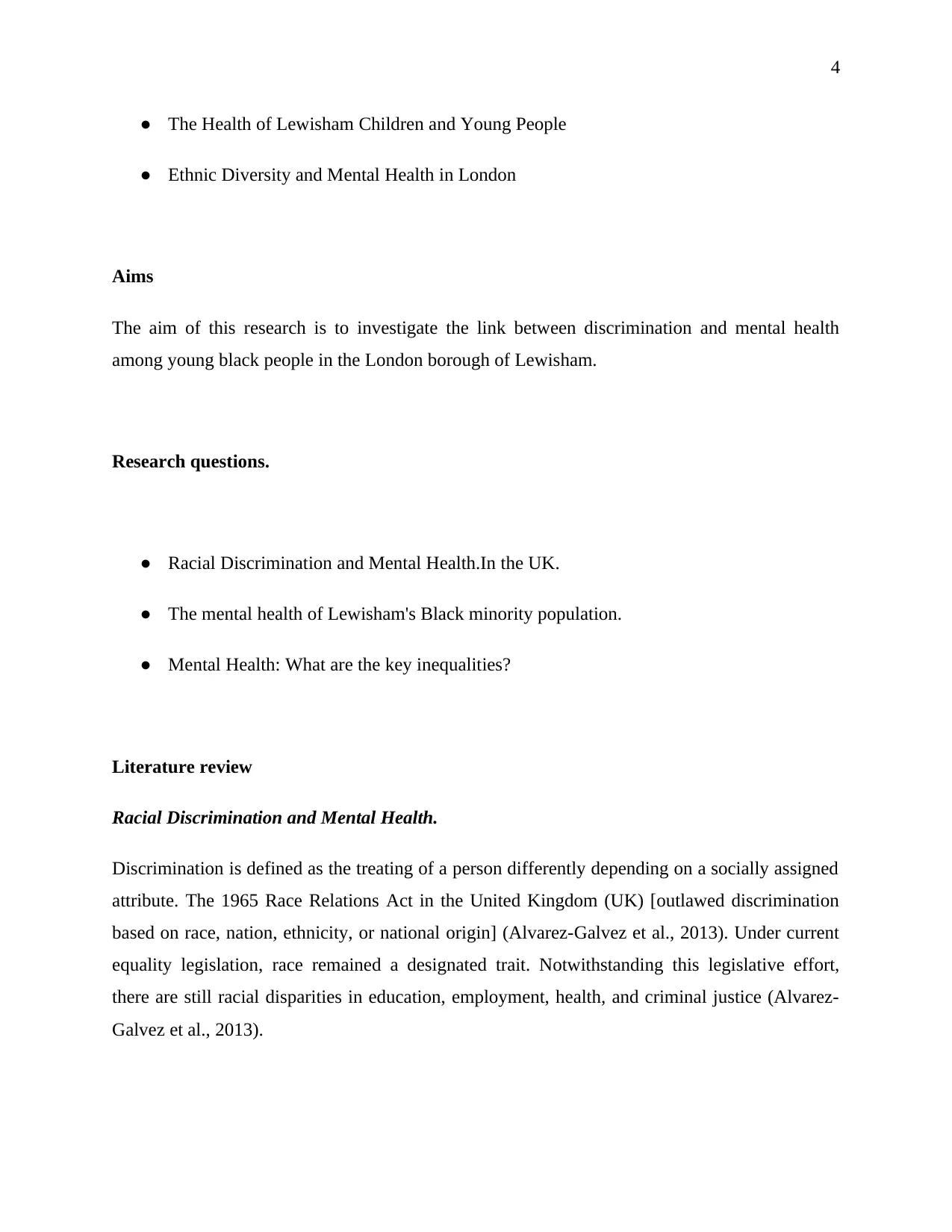
4
● The Health of Lewisham Children and Young People
● Ethnic Diversity and Mental Health in London
Aims
The aim of this research is to investigate the link between discrimination and mental health
among young black people in the London borough of Lewisham.
Research questions.
● Racial Discrimination and Mental Health.In the UK.
● The mental health of Lewisham's Black minority population.
● Mental Health: What are the key inequalities?
Literature review
Racial Discrimination and Mental Health.
Discrimination is defined as the treating of a person differently depending on a socially assigned
attribute. The 1965 Race Relations Act in the United Kingdom (UK) [outlawed discrimination
based on race, nation, ethnicity, or national origin] (Alvarez-Galvez et al., 2013). Under current
equality legislation, race remained a designated trait. Notwithstanding this legislative effort,
there are still racial disparities in education, employment, health, and criminal justice (Alvarez-
Galvez et al., 2013).
● The Health of Lewisham Children and Young People
● Ethnic Diversity and Mental Health in London
Aims
The aim of this research is to investigate the link between discrimination and mental health
among young black people in the London borough of Lewisham.
Research questions.
● Racial Discrimination and Mental Health.In the UK.
● The mental health of Lewisham's Black minority population.
● Mental Health: What are the key inequalities?
Literature review
Racial Discrimination and Mental Health.
Discrimination is defined as the treating of a person differently depending on a socially assigned
attribute. The 1965 Race Relations Act in the United Kingdom (UK) [outlawed discrimination
based on race, nation, ethnicity, or national origin] (Alvarez-Galvez et al., 2013). Under current
equality legislation, race remained a designated trait. Notwithstanding this legislative effort,
there are still racial disparities in education, employment, health, and criminal justice (Alvarez-
Galvez et al., 2013).
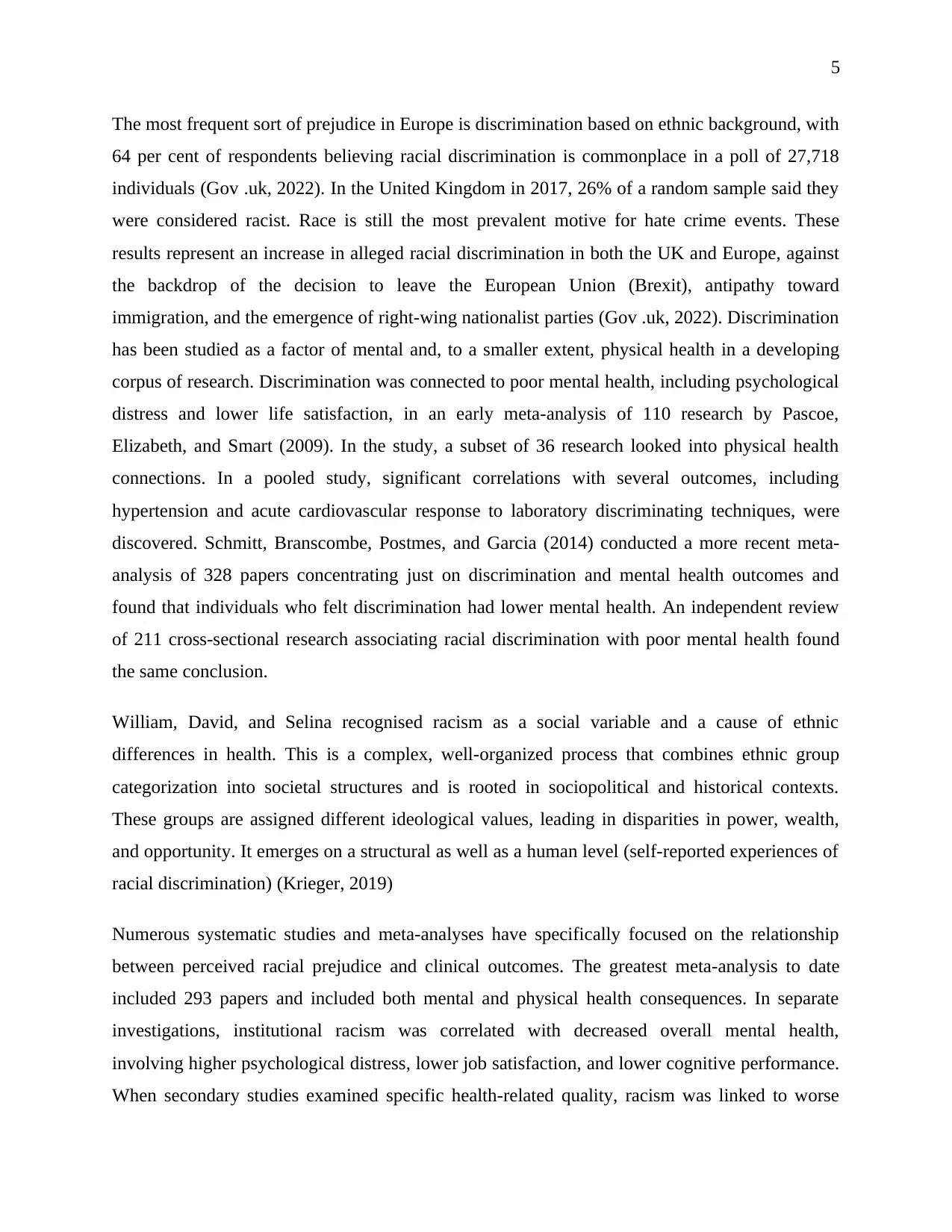
5
The most frequent sort of prejudice in Europe is discrimination based on ethnic background, with
64 per cent of respondents believing racial discrimination is commonplace in a poll of 27,718
individuals (Gov .uk, 2022). In the United Kingdom in 2017, 26% of a random sample said they
were considered racist. Race is still the most prevalent motive for hate crime events. These
results represent an increase in alleged racial discrimination in both the UK and Europe, against
the backdrop of the decision to leave the European Union (Brexit), antipathy toward
immigration, and the emergence of right-wing nationalist parties (Gov .uk, 2022). Discrimination
has been studied as a factor of mental and, to a smaller extent, physical health in a developing
corpus of research. Discrimination was connected to poor mental health, including psychological
distress and lower life satisfaction, in an early meta-analysis of 110 research by Pascoe,
Elizabeth, and Smart (2009). In the study, a subset of 36 research looked into physical health
connections. In a pooled study, significant correlations with several outcomes, including
hypertension and acute cardiovascular response to laboratory discriminating techniques, were
discovered. Schmitt, Branscombe, Postmes, and Garcia (2014) conducted a more recent meta-
analysis of 328 papers concentrating just on discrimination and mental health outcomes and
found that individuals who felt discrimination had lower mental health. An independent review
of 211 cross-sectional research associating racial discrimination with poor mental health found
the same conclusion.
William, David, and Selina recognised racism as a social variable and a cause of ethnic
differences in health. This is a complex, well-organized process that combines ethnic group
categorization into societal structures and is rooted in sociopolitical and historical contexts.
These groups are assigned different ideological values, leading in disparities in power, wealth,
and opportunity. It emerges on a structural as well as a human level (self-reported experiences of
racial discrimination) (Krieger, 2019)
Numerous systematic studies and meta-analyses have specifically focused on the relationship
between perceived racial prejudice and clinical outcomes. The greatest meta-analysis to date
included 293 papers and included both mental and physical health consequences. In separate
investigations, institutional racism was correlated with decreased overall mental health,
involving higher psychological distress, lower job satisfaction, and lower cognitive performance.
When secondary studies examined specific health-related quality, racism was linked to worse
The most frequent sort of prejudice in Europe is discrimination based on ethnic background, with
64 per cent of respondents believing racial discrimination is commonplace in a poll of 27,718
individuals (Gov .uk, 2022). In the United Kingdom in 2017, 26% of a random sample said they
were considered racist. Race is still the most prevalent motive for hate crime events. These
results represent an increase in alleged racial discrimination in both the UK and Europe, against
the backdrop of the decision to leave the European Union (Brexit), antipathy toward
immigration, and the emergence of right-wing nationalist parties (Gov .uk, 2022). Discrimination
has been studied as a factor of mental and, to a smaller extent, physical health in a developing
corpus of research. Discrimination was connected to poor mental health, including psychological
distress and lower life satisfaction, in an early meta-analysis of 110 research by Pascoe,
Elizabeth, and Smart (2009). In the study, a subset of 36 research looked into physical health
connections. In a pooled study, significant correlations with several outcomes, including
hypertension and acute cardiovascular response to laboratory discriminating techniques, were
discovered. Schmitt, Branscombe, Postmes, and Garcia (2014) conducted a more recent meta-
analysis of 328 papers concentrating just on discrimination and mental health outcomes and
found that individuals who felt discrimination had lower mental health. An independent review
of 211 cross-sectional research associating racial discrimination with poor mental health found
the same conclusion.
William, David, and Selina recognised racism as a social variable and a cause of ethnic
differences in health. This is a complex, well-organized process that combines ethnic group
categorization into societal structures and is rooted in sociopolitical and historical contexts.
These groups are assigned different ideological values, leading in disparities in power, wealth,
and opportunity. It emerges on a structural as well as a human level (self-reported experiences of
racial discrimination) (Krieger, 2019)
Numerous systematic studies and meta-analyses have specifically focused on the relationship
between perceived racial prejudice and clinical outcomes. The greatest meta-analysis to date
included 293 papers and included both mental and physical health consequences. In separate
investigations, institutional racism was correlated with decreased overall mental health,
involving higher psychological distress, lower job satisfaction, and lower cognitive performance.
When secondary studies examined specific health-related quality, racism was linked to worse
⊘ This is a preview!⊘
Do you want full access?
Subscribe today to unlock all pages.

Trusted by 1+ million students worldwide
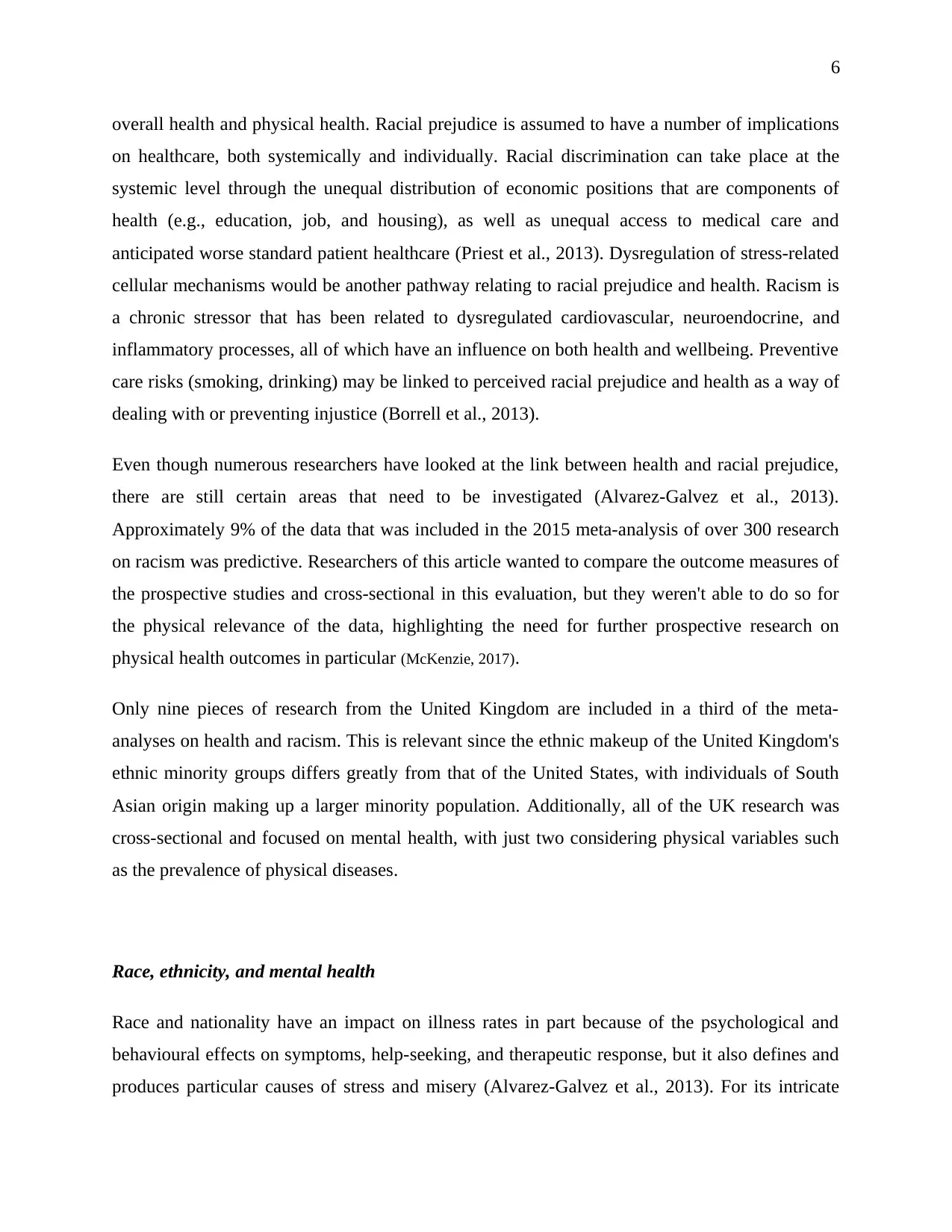
6
overall health and physical health. Racial prejudice is assumed to have a number of implications
on healthcare, both systemically and individually. Racial discrimination can take place at the
systemic level through the unequal distribution of economic positions that are components of
health (e.g., education, job, and housing), as well as unequal access to medical care and
anticipated worse standard patient healthcare (Priest et al., 2013). Dysregulation of stress-related
cellular mechanisms would be another pathway relating to racial prejudice and health. Racism is
a chronic stressor that has been related to dysregulated cardiovascular, neuroendocrine, and
inflammatory processes, all of which have an influence on both health and wellbeing. Preventive
care risks (smoking, drinking) may be linked to perceived racial prejudice and health as a way of
dealing with or preventing injustice (Borrell et al., 2013).
Even though numerous researchers have looked at the link between health and racial prejudice,
there are still certain areas that need to be investigated (Alvarez-Galvez et al., 2013).
Approximately 9% of the data that was included in the 2015 meta-analysis of over 300 research
on racism was predictive. Researchers of this article wanted to compare the outcome measures of
the prospective studies and cross-sectional in this evaluation, but they weren't able to do so for
the physical relevance of the data, highlighting the need for further prospective research on
physical health outcomes in particular (McKenzie, 2017).
Only nine pieces of research from the United Kingdom are included in a third of the meta-
analyses on health and racism. This is relevant since the ethnic makeup of the United Kingdom's
ethnic minority groups differs greatly from that of the United States, with individuals of South
Asian origin making up a larger minority population. Additionally, all of the UK research was
cross-sectional and focused on mental health, with just two considering physical variables such
as the prevalence of physical diseases.
Race, ethnicity, and mental health
Race and nationality have an impact on illness rates in part because of the psychological and
behavioural effects on symptoms, help-seeking, and therapeutic response, but it also defines and
produces particular causes of stress and misery (Alvarez-Galvez et al., 2013). For its intricate
overall health and physical health. Racial prejudice is assumed to have a number of implications
on healthcare, both systemically and individually. Racial discrimination can take place at the
systemic level through the unequal distribution of economic positions that are components of
health (e.g., education, job, and housing), as well as unequal access to medical care and
anticipated worse standard patient healthcare (Priest et al., 2013). Dysregulation of stress-related
cellular mechanisms would be another pathway relating to racial prejudice and health. Racism is
a chronic stressor that has been related to dysregulated cardiovascular, neuroendocrine, and
inflammatory processes, all of which have an influence on both health and wellbeing. Preventive
care risks (smoking, drinking) may be linked to perceived racial prejudice and health as a way of
dealing with or preventing injustice (Borrell et al., 2013).
Even though numerous researchers have looked at the link between health and racial prejudice,
there are still certain areas that need to be investigated (Alvarez-Galvez et al., 2013).
Approximately 9% of the data that was included in the 2015 meta-analysis of over 300 research
on racism was predictive. Researchers of this article wanted to compare the outcome measures of
the prospective studies and cross-sectional in this evaluation, but they weren't able to do so for
the physical relevance of the data, highlighting the need for further prospective research on
physical health outcomes in particular (McKenzie, 2017).
Only nine pieces of research from the United Kingdom are included in a third of the meta-
analyses on health and racism. This is relevant since the ethnic makeup of the United Kingdom's
ethnic minority groups differs greatly from that of the United States, with individuals of South
Asian origin making up a larger minority population. Additionally, all of the UK research was
cross-sectional and focused on mental health, with just two considering physical variables such
as the prevalence of physical diseases.
Race, ethnicity, and mental health
Race and nationality have an impact on illness rates in part because of the psychological and
behavioural effects on symptoms, help-seeking, and therapeutic response, but it also defines and
produces particular causes of stress and misery (Alvarez-Galvez et al., 2013). For its intricate
Paraphrase This Document
Need a fresh take? Get an instant paraphrase of this document with our AI Paraphraser
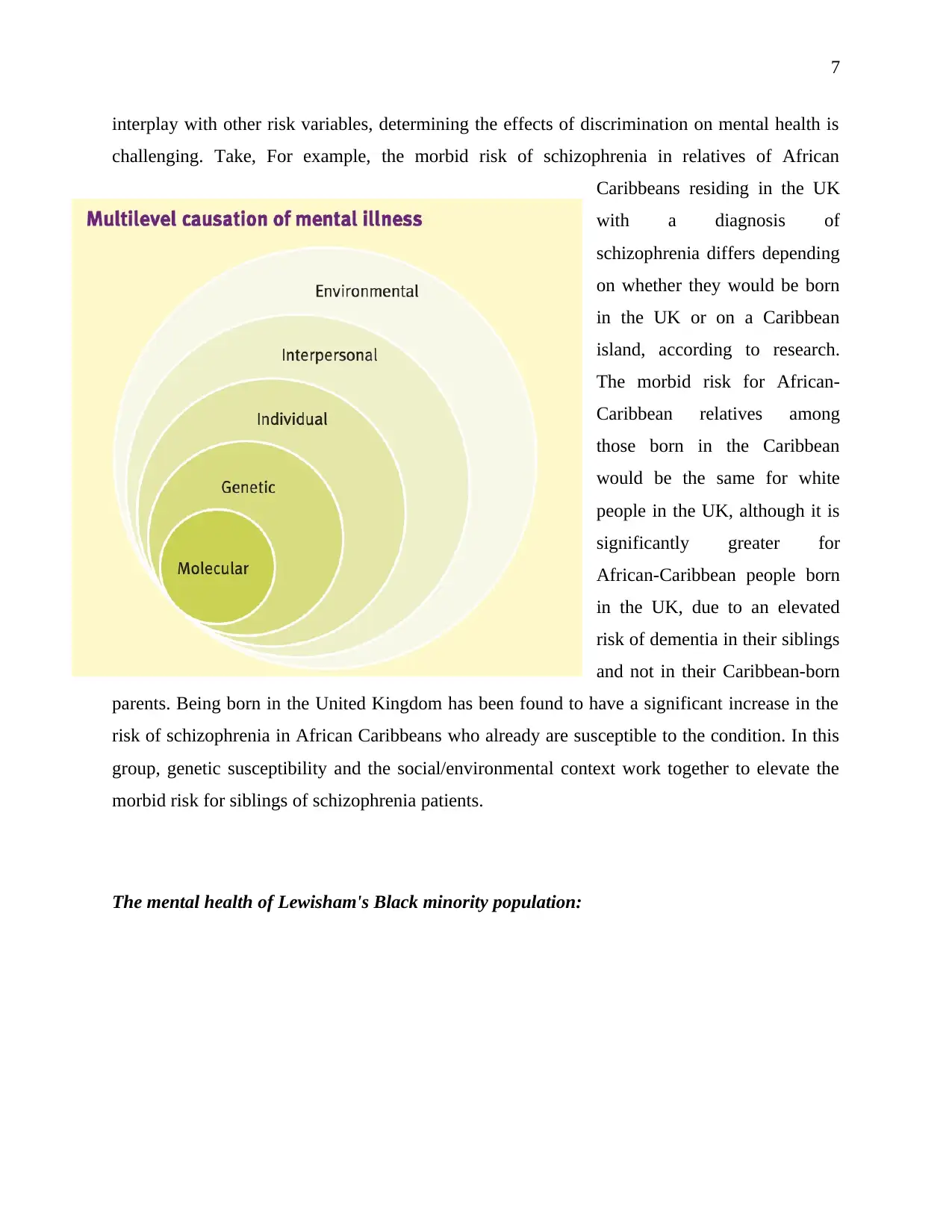
7
interplay with other risk variables, determining the effects of discrimination on mental health is
challenging. Take, For example, the morbid risk of schizophrenia in relatives of African
Caribbeans residing in the UK
with a diagnosis of
schizophrenia differs depending
on whether they would be born
in the UK or on a Caribbean
island, according to research.
The morbid risk for African-
Caribbean relatives among
those born in the Caribbean
would be the same for white
people in the UK, although it is
significantly greater for
African-Caribbean people born
in the UK, due to an elevated
risk of dementia in their siblings
and not in their Caribbean-born
parents. Being born in the United Kingdom has been found to have a significant increase in the
risk of schizophrenia in African Caribbeans who already are susceptible to the condition. In this
group, genetic susceptibility and the social/environmental context work together to elevate the
morbid risk for siblings of schizophrenia patients.
The mental health of Lewisham's Black minority population:
interplay with other risk variables, determining the effects of discrimination on mental health is
challenging. Take, For example, the morbid risk of schizophrenia in relatives of African
Caribbeans residing in the UK
with a diagnosis of
schizophrenia differs depending
on whether they would be born
in the UK or on a Caribbean
island, according to research.
The morbid risk for African-
Caribbean relatives among
those born in the Caribbean
would be the same for white
people in the UK, although it is
significantly greater for
African-Caribbean people born
in the UK, due to an elevated
risk of dementia in their siblings
and not in their Caribbean-born
parents. Being born in the United Kingdom has been found to have a significant increase in the
risk of schizophrenia in African Caribbeans who already are susceptible to the condition. In this
group, genetic susceptibility and the social/environmental context work together to elevate the
morbid risk for siblings of schizophrenia patients.
The mental health of Lewisham's Black minority population:
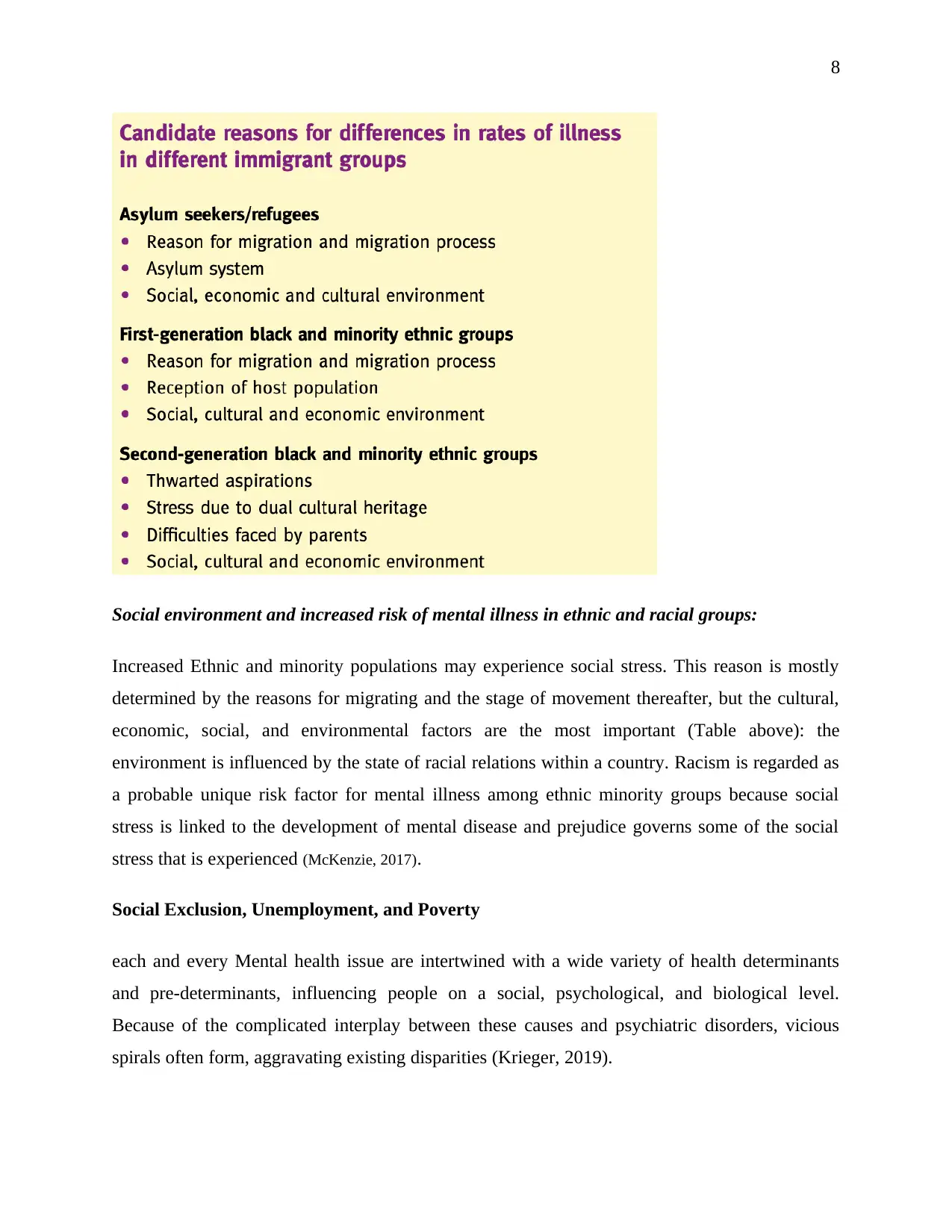
8
Social environment and increased risk of mental illness in ethnic and racial groups:
Increased Ethnic and minority populations may experience social stress. This reason is mostly
determined by the reasons for migrating and the stage of movement thereafter, but the cultural,
economic, social, and environmental factors are the most important (Table above): the
environment is influenced by the state of racial relations within a country. Racism is regarded as
a probable unique risk factor for mental illness among ethnic minority groups because social
stress is linked to the development of mental disease and prejudice governs some of the social
stress that is experienced (McKenzie, 2017).
Social Exclusion, Unemployment, and Poverty
each and every Mental health issue are intertwined with a wide variety of health determinants
and pre-determinants, influencing people on a social, psychological, and biological level.
Because of the complicated interplay between these causes and psychiatric disorders, vicious
spirals often form, aggravating existing disparities (Krieger, 2019).
Social environment and increased risk of mental illness in ethnic and racial groups:
Increased Ethnic and minority populations may experience social stress. This reason is mostly
determined by the reasons for migrating and the stage of movement thereafter, but the cultural,
economic, social, and environmental factors are the most important (Table above): the
environment is influenced by the state of racial relations within a country. Racism is regarded as
a probable unique risk factor for mental illness among ethnic minority groups because social
stress is linked to the development of mental disease and prejudice governs some of the social
stress that is experienced (McKenzie, 2017).
Social Exclusion, Unemployment, and Poverty
each and every Mental health issue are intertwined with a wide variety of health determinants
and pre-determinants, influencing people on a social, psychological, and biological level.
Because of the complicated interplay between these causes and psychiatric disorders, vicious
spirals often form, aggravating existing disparities (Krieger, 2019).
⊘ This is a preview!⊘
Do you want full access?
Subscribe today to unlock all pages.

Trusted by 1+ million students worldwide
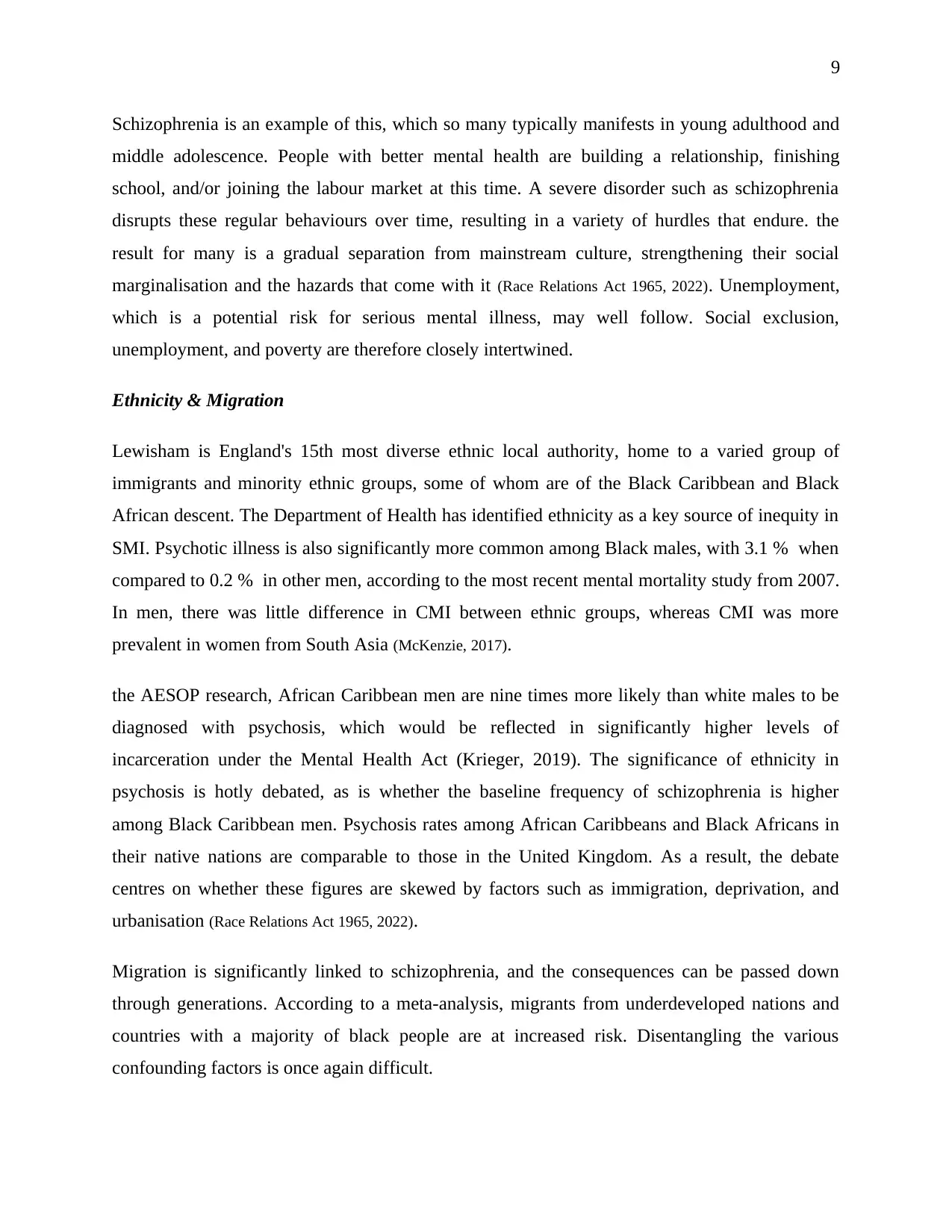
9
Schizophrenia is an example of this, which so many typically manifests in young adulthood and
middle adolescence. People with better mental health are building a relationship, finishing
school, and/or joining the labour market at this time. A severe disorder such as schizophrenia
disrupts these regular behaviours over time, resulting in a variety of hurdles that endure. the
result for many is a gradual separation from mainstream culture, strengthening their social
marginalisation and the hazards that come with it (Race Relations Act 1965, 2022). Unemployment,
which is a potential risk for serious mental illness, may well follow. Social exclusion,
unemployment, and poverty are therefore closely intertwined.
Ethnicity & Migration
Lewisham is England's 15th most diverse ethnic local authority, home to a varied group of
immigrants and minority ethnic groups, some of whom are of the Black Caribbean and Black
African descent. The Department of Health has identified ethnicity as a key source of inequity in
SMI. Psychotic illness is also significantly more common among Black males, with 3.1 % when
compared to 0.2 % in other men, according to the most recent mental mortality study from 2007.
In men, there was little difference in CMI between ethnic groups, whereas CMI was more
prevalent in women from South Asia (McKenzie, 2017).
the AESOP research, African Caribbean men are nine times more likely than white males to be
diagnosed with psychosis, which would be reflected in significantly higher levels of
incarceration under the Mental Health Act (Krieger, 2019). The significance of ethnicity in
psychosis is hotly debated, as is whether the baseline frequency of schizophrenia is higher
among Black Caribbean men. Psychosis rates among African Caribbeans and Black Africans in
their native nations are comparable to those in the United Kingdom. As a result, the debate
centres on whether these figures are skewed by factors such as immigration, deprivation, and
urbanisation (Race Relations Act 1965, 2022).
Migration is significantly linked to schizophrenia, and the consequences can be passed down
through generations. According to a meta-analysis, migrants from underdeveloped nations and
countries with a majority of black people are at increased risk. Disentangling the various
confounding factors is once again difficult.
Schizophrenia is an example of this, which so many typically manifests in young adulthood and
middle adolescence. People with better mental health are building a relationship, finishing
school, and/or joining the labour market at this time. A severe disorder such as schizophrenia
disrupts these regular behaviours over time, resulting in a variety of hurdles that endure. the
result for many is a gradual separation from mainstream culture, strengthening their social
marginalisation and the hazards that come with it (Race Relations Act 1965, 2022). Unemployment,
which is a potential risk for serious mental illness, may well follow. Social exclusion,
unemployment, and poverty are therefore closely intertwined.
Ethnicity & Migration
Lewisham is England's 15th most diverse ethnic local authority, home to a varied group of
immigrants and minority ethnic groups, some of whom are of the Black Caribbean and Black
African descent. The Department of Health has identified ethnicity as a key source of inequity in
SMI. Psychotic illness is also significantly more common among Black males, with 3.1 % when
compared to 0.2 % in other men, according to the most recent mental mortality study from 2007.
In men, there was little difference in CMI between ethnic groups, whereas CMI was more
prevalent in women from South Asia (McKenzie, 2017).
the AESOP research, African Caribbean men are nine times more likely than white males to be
diagnosed with psychosis, which would be reflected in significantly higher levels of
incarceration under the Mental Health Act (Krieger, 2019). The significance of ethnicity in
psychosis is hotly debated, as is whether the baseline frequency of schizophrenia is higher
among Black Caribbean men. Psychosis rates among African Caribbeans and Black Africans in
their native nations are comparable to those in the United Kingdom. As a result, the debate
centres on whether these figures are skewed by factors such as immigration, deprivation, and
urbanisation (Race Relations Act 1965, 2022).
Migration is significantly linked to schizophrenia, and the consequences can be passed down
through generations. According to a meta-analysis, migrants from underdeveloped nations and
countries with a majority of black people are at increased risk. Disentangling the various
confounding factors is once again difficult.
Paraphrase This Document
Need a fresh take? Get an instant paraphrase of this document with our AI Paraphraser
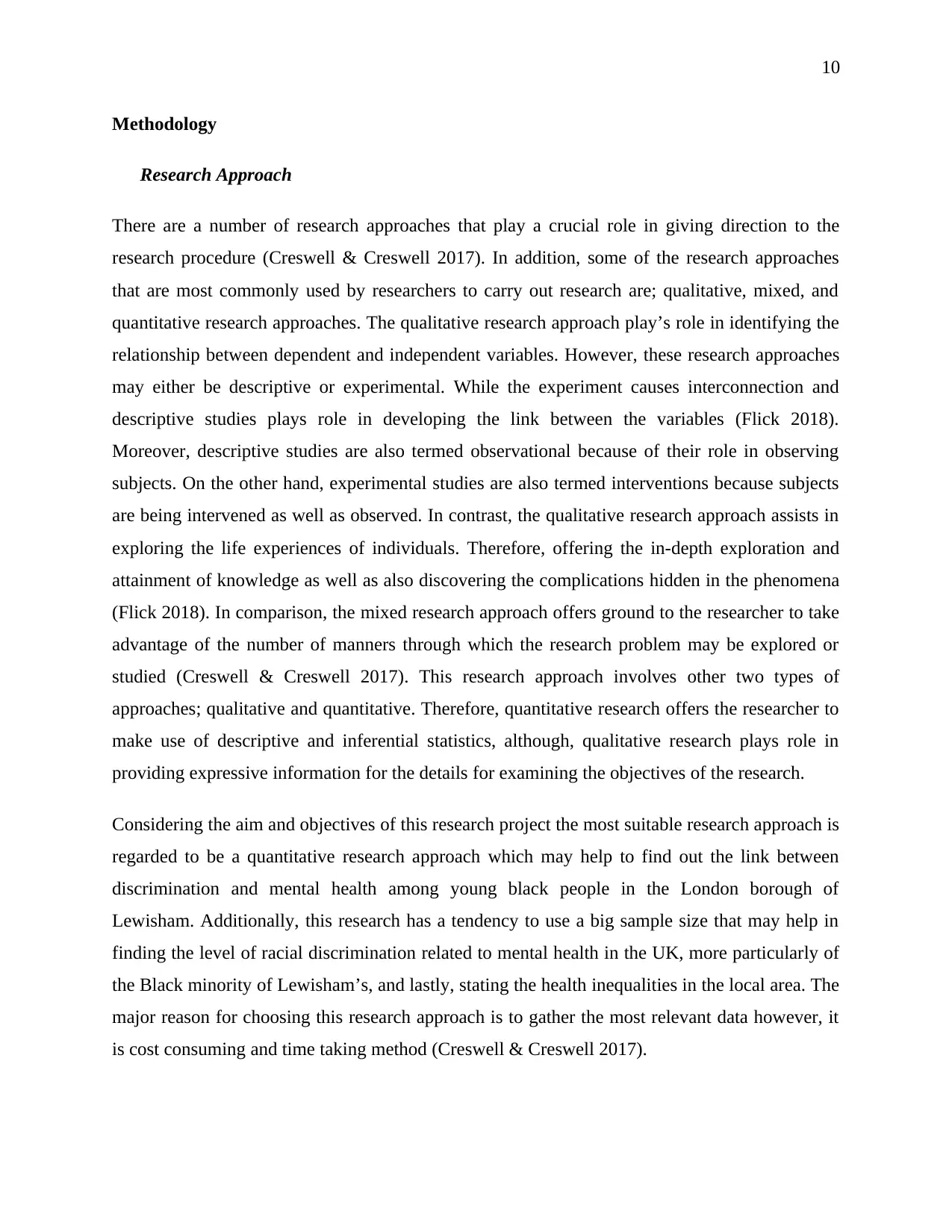
10
Methodology
Research Approach
There are a number of research approaches that play a crucial role in giving direction to the
research procedure (Creswell & Creswell 2017). In addition, some of the research approaches
that are most commonly used by researchers to carry out research are; qualitative, mixed, and
quantitative research approaches. The qualitative research approach play’s role in identifying the
relationship between dependent and independent variables. However, these research approaches
may either be descriptive or experimental. While the experiment causes interconnection and
descriptive studies plays role in developing the link between the variables (Flick 2018).
Moreover, descriptive studies are also termed observational because of their role in observing
subjects. On the other hand, experimental studies are also termed interventions because subjects
are being intervened as well as observed. In contrast, the qualitative research approach assists in
exploring the life experiences of individuals. Therefore, offering the in-depth exploration and
attainment of knowledge as well as also discovering the complications hidden in the phenomena
(Flick 2018). In comparison, the mixed research approach offers ground to the researcher to take
advantage of the number of manners through which the research problem may be explored or
studied (Creswell & Creswell 2017). This research approach involves other two types of
approaches; qualitative and quantitative. Therefore, quantitative research offers the researcher to
make use of descriptive and inferential statistics, although, qualitative research plays role in
providing expressive information for the details for examining the objectives of the research.
Considering the aim and objectives of this research project the most suitable research approach is
regarded to be a quantitative research approach which may help to find out the link between
discrimination and mental health among young black people in the London borough of
Lewisham. Additionally, this research has a tendency to use a big sample size that may help in
finding the level of racial discrimination related to mental health in the UK, more particularly of
the Black minority of Lewisham’s, and lastly, stating the health inequalities in the local area. The
major reason for choosing this research approach is to gather the most relevant data however, it
is cost consuming and time taking method (Creswell & Creswell 2017).
Methodology
Research Approach
There are a number of research approaches that play a crucial role in giving direction to the
research procedure (Creswell & Creswell 2017). In addition, some of the research approaches
that are most commonly used by researchers to carry out research are; qualitative, mixed, and
quantitative research approaches. The qualitative research approach play’s role in identifying the
relationship between dependent and independent variables. However, these research approaches
may either be descriptive or experimental. While the experiment causes interconnection and
descriptive studies plays role in developing the link between the variables (Flick 2018).
Moreover, descriptive studies are also termed observational because of their role in observing
subjects. On the other hand, experimental studies are also termed interventions because subjects
are being intervened as well as observed. In contrast, the qualitative research approach assists in
exploring the life experiences of individuals. Therefore, offering the in-depth exploration and
attainment of knowledge as well as also discovering the complications hidden in the phenomena
(Flick 2018). In comparison, the mixed research approach offers ground to the researcher to take
advantage of the number of manners through which the research problem may be explored or
studied (Creswell & Creswell 2017). This research approach involves other two types of
approaches; qualitative and quantitative. Therefore, quantitative research offers the researcher to
make use of descriptive and inferential statistics, although, qualitative research plays role in
providing expressive information for the details for examining the objectives of the research.
Considering the aim and objectives of this research project the most suitable research approach is
regarded to be a quantitative research approach which may help to find out the link between
discrimination and mental health among young black people in the London borough of
Lewisham. Additionally, this research has a tendency to use a big sample size that may help in
finding the level of racial discrimination related to mental health in the UK, more particularly of
the Black minority of Lewisham’s, and lastly, stating the health inequalities in the local area. The
major reason for choosing this research approach is to gather the most relevant data however, it
is cost consuming and time taking method (Creswell & Creswell 2017).
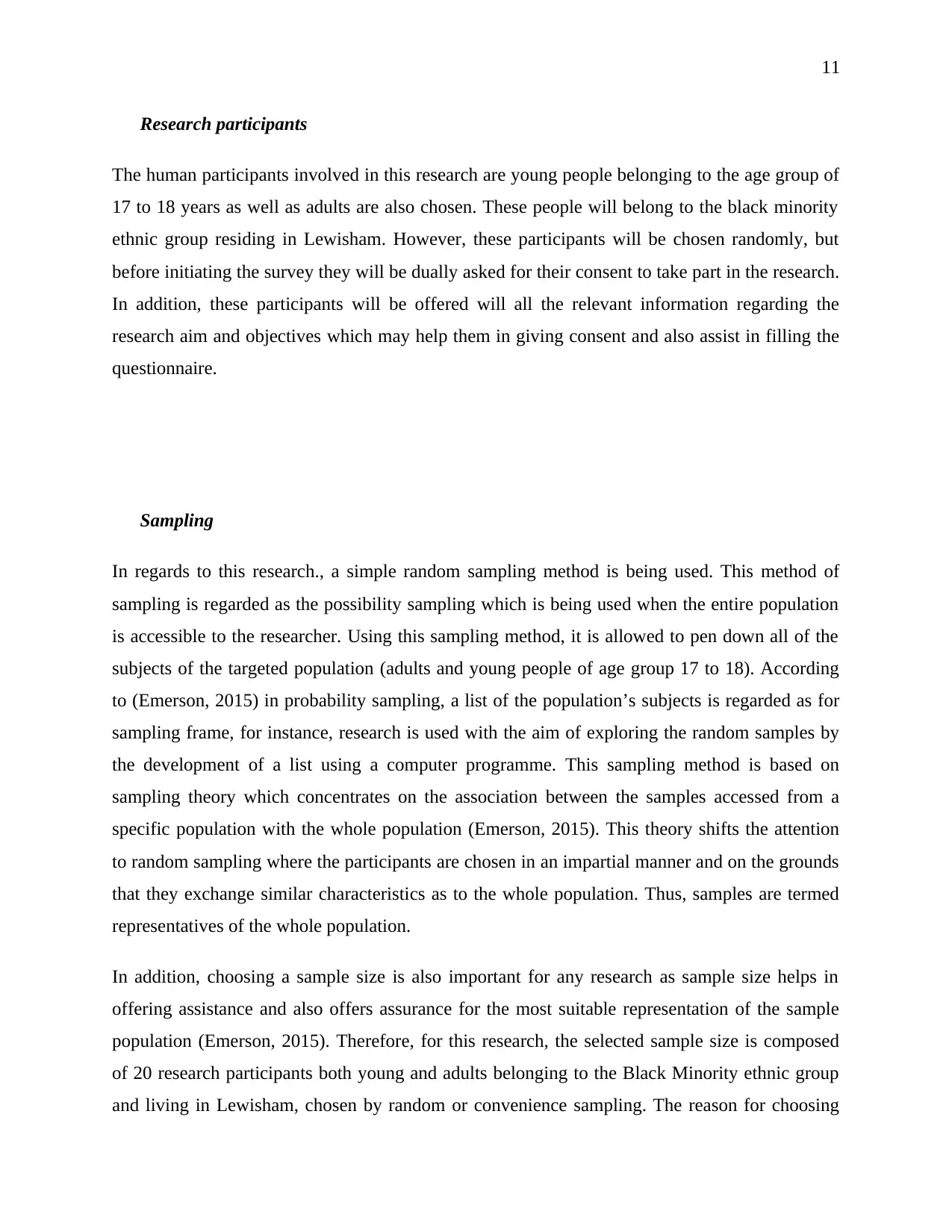
11
Research participants
The human participants involved in this research are young people belonging to the age group of
17 to 18 years as well as adults are also chosen. These people will belong to the black minority
ethnic group residing in Lewisham. However, these participants will be chosen randomly, but
before initiating the survey they will be dually asked for their consent to take part in the research.
In addition, these participants will be offered will all the relevant information regarding the
research aim and objectives which may help them in giving consent and also assist in filling the
questionnaire.
Sampling
In regards to this research., a simple random sampling method is being used. This method of
sampling is regarded as the possibility sampling which is being used when the entire population
is accessible to the researcher. Using this sampling method, it is allowed to pen down all of the
subjects of the targeted population (adults and young people of age group 17 to 18). According
to (Emerson, 2015) in probability sampling, a list of the population’s subjects is regarded as for
sampling frame, for instance, research is used with the aim of exploring the random samples by
the development of a list using a computer programme. This sampling method is based on
sampling theory which concentrates on the association between the samples accessed from a
specific population with the whole population (Emerson, 2015). This theory shifts the attention
to random sampling where the participants are chosen in an impartial manner and on the grounds
that they exchange similar characteristics as to the whole population. Thus, samples are termed
representatives of the whole population.
In addition, choosing a sample size is also important for any research as sample size helps in
offering assistance and also offers assurance for the most suitable representation of the sample
population (Emerson, 2015). Therefore, for this research, the selected sample size is composed
of 20 research participants both young and adults belonging to the Black Minority ethnic group
and living in Lewisham, chosen by random or convenience sampling. The reason for choosing
Research participants
The human participants involved in this research are young people belonging to the age group of
17 to 18 years as well as adults are also chosen. These people will belong to the black minority
ethnic group residing in Lewisham. However, these participants will be chosen randomly, but
before initiating the survey they will be dually asked for their consent to take part in the research.
In addition, these participants will be offered will all the relevant information regarding the
research aim and objectives which may help them in giving consent and also assist in filling the
questionnaire.
Sampling
In regards to this research., a simple random sampling method is being used. This method of
sampling is regarded as the possibility sampling which is being used when the entire population
is accessible to the researcher. Using this sampling method, it is allowed to pen down all of the
subjects of the targeted population (adults and young people of age group 17 to 18). According
to (Emerson, 2015) in probability sampling, a list of the population’s subjects is regarded as for
sampling frame, for instance, research is used with the aim of exploring the random samples by
the development of a list using a computer programme. This sampling method is based on
sampling theory which concentrates on the association between the samples accessed from a
specific population with the whole population (Emerson, 2015). This theory shifts the attention
to random sampling where the participants are chosen in an impartial manner and on the grounds
that they exchange similar characteristics as to the whole population. Thus, samples are termed
representatives of the whole population.
In addition, choosing a sample size is also important for any research as sample size helps in
offering assistance and also offers assurance for the most suitable representation of the sample
population (Emerson, 2015). Therefore, for this research, the selected sample size is composed
of 20 research participants both young and adults belonging to the Black Minority ethnic group
and living in Lewisham, chosen by random or convenience sampling. The reason for choosing
⊘ This is a preview!⊘
Do you want full access?
Subscribe today to unlock all pages.

Trusted by 1+ million students worldwide
1 out of 24
Related Documents
Your All-in-One AI-Powered Toolkit for Academic Success.
+13062052269
info@desklib.com
Available 24*7 on WhatsApp / Email
![[object Object]](/_next/static/media/star-bottom.7253800d.svg)
Unlock your academic potential
Copyright © 2020–2025 A2Z Services. All Rights Reserved. Developed and managed by ZUCOL.




